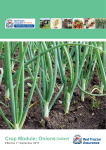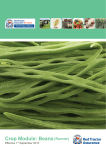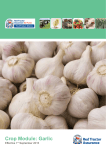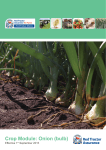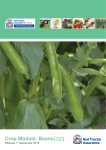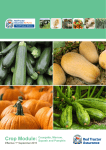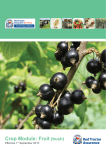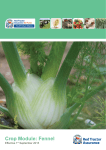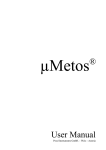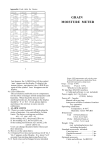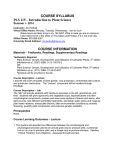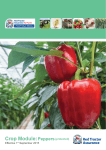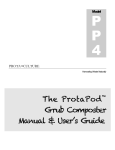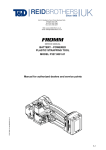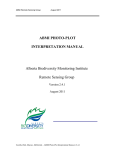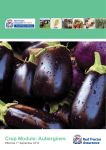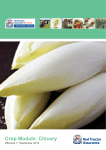Download Crop Module: Celeriac - Red Tractor Assurance
Transcript
Crop Module: Celeriac Effective 1st September 2015 Welcome T his crop specific module for celeriac has been written to complement and avoid duplicating the generic principles of the Red Tractor Farm Assurance Fresh Produce Scheme standards. It is advisable to read the Red Tractor Farm Assurance Fresh Produce standards before reading this crop specific module. This module is designed to stimulate thought in the mind of the reader. It contains crop specific guidance and standards, where applicable, in addition to the requirements stated in the generic Fresh Produce standards. Within this module the important requirements outlined in the crop specific standards section will be verified during the Red Tractor Farm Assurance assessment and compliance will form a part of the certification/approval decision. Disclaimer and trade mark acknowledgement Although every effort has been made to ensure accuracy, Assured Food Standards does not accept any responsibility for errors and omissions. Trade names are only used in this module where use of that specific product is essential. All such products are annotated® and all trademark rights are hereby acknowledged. General Introduction Following a systematic approach will help growers identify and manage the risks involved in crop production. This module is based on a typical crop production process and food safety, health & safety, environmental and quality hazards are identified. Appropriate controls may then be established to minimise risk. Food safety and health & safety issues always take precedent over quality and environmental controls. The layout of this module follows the same structure as that used in the Red Tractor Farm Assurance Fresh Produce Standards. The content of the module is reviewed prior to the issue of updated editions. The review process considers both new developments and all relevant technology which has emerged since the last review was completed and which have been found to be both workable by the grower and beneficial to the environment. The aim is to transfer such information and technologies to growers. Acknowledgements Red Tractor Farm Assurance Fresh Produce gratefully acknowledges the contribution of all consultees in the preparation of this protocol, particularly Robin Buck and Julian Perowne of Jack Buck (Farms) Ltd. Notes: Pesticide Information The Red Tractor Fresh Produce team has been working with Fera to provide tailored access to the LIAISON database for all Red Tractor Fresh Produce members. This system allows individual growers access to all information for plant protection products approved for use under the Red Tractor Fresh Produce Scheme. LIAISON can be accessed under the Produce tab via the “Checkers and Services” page where you will also find a user manual. Searches will be filtered specifically for the crops for which you are registered. Once you have logged onto the site and clicked on the LIAISON hyperlink you will be directed to the LIAISON home screen. You will need a username and password and these will be sent once you have registered: http://assurance.redtractor.org.uk/rtassurance/ services/Registration/members.eb . Front cover image credit: Jack Buck Farms. 1 Red Tractor Assurance for Farms – Crop-specific Module: Celeriac © Assured Food Standards 2015 Content Contents ADDITIONAL REQUIREMENTS AGAINST CURRENT STANDARDS 02 CROP SPECIFIC STANDARDS02 CHOICE OF VARIETY OR ROOTSTOCK AND PLANT HEALTH CERTIFICATION 03 SITE AND SOIL MANAGEMENT 03 ENVIRONMENTAL PROTECTION AND CONTAMINATION CONTROL04 PEST, DISEASE AND WEED CONTROL05 NUTRITION09 HARVEST AND STORAGE 10 RESIDUES AND CONTAMINANTS 10 APPENDIX 1: TYPICAL APPLICATION RATES FOR NUTRIENTS11 ADDITIONAL REQUIREMENTS AGAINST CURRENT STANDARDS None for this crop module CROP SPECIFIC STANDARDS STANDARDS HOW YOU WILL BE MEASURED RECORDS (to be kept for 2 years) CQ.54.a n Table n Soil/ Macro and micronutrient must be tested by assessing samples of soil or leaf tissue in the celeriac protocol text provides further information leaf tissue testing results n Soil CQ.54.b Soil nitrates must be monitored in the growing season Red Tractor Assurance for Farms – Crop-specific Module: Celeriac nitrate monitoring records © Assured Food Standards 2015 2 GUIDANCE CHOICE OF VARIETY OR ROOTSTOCK AND PLANT HEALTH CERTIFICATION DEFINITIONS Celeriac (Apium graveolens var. rapaceum) belongs to the umbelliferae plant family, which also includes carrots, parsnips, and celery. Umbelliferous herbs and spices include parsley, fennel, dill, chervil, lovage, angelica, caraway, aniseed and cumin. Important umbelliferous weeds prevalent in the UK include cow parsley, fools parsley and hemlock. Celeriac is a biennial, growing vegetatively from seed in the first year into a swollen stem storage organ following leaf senescence in the autumn. Re-growth in the following spring produces a flowering stalk and, following fertilisation; seeds are produced in the late spring/early summer. Celeriac is similar to celery exhibiting similar shaped leaf petioles and leaflets. The leaf bases are attached to the stem. As swelling of the stem occurs rapidly in the autumn, harvesting is generally left until late October and into November to maximise yield. SITE AND SOIL MANAGEMENT SITE SITUATION Celeriac originates in the Mediterranean basin and has warm temperate growth requirements. Optimal temperatures for growth lie between 15°C and 18°C, growth ceases at below 7°C and above 24°C. For this reason it is important that cold sites (e.g. shaded by woods, north facing, etc.) are avoided. South facing fields offer the best thermal advantage. 3 ROTATION Site diseases Celeriac is susceptible to the same range of diseases as celery. The following soil-borne diseases may build up if celeriac is cropped in a close rotation: Grey mould rot (Botrytis cinerea), licorice rot (Mycocentrospora acerina), phoma rot (Phoma apiicola), watery soft rot also called pink rot (Sclerotinia minor [Jagger]) and (Sclerotinia sclerotiorium [Lib.] de Bary), black rot (Alternaria radicina), crater rot (Rhizoctonia solani) and fusarium rot (Fusarium oxysporum). The following diseases persist as spores in crop debris buried in soil: Sclerotinia, Septoria Spot (Septoria apiicola) also called Late Blight. The following soil-borne diseases may attack celeriac during post-harvest storage: Licorice rot, phoma rot, Botrytis, Pseudomonas spp., and Sclerotinia. Erwinia spp., These pathogens generally need free moisture and/ or high humidity to develop and express symptoms on produce in store. Good air flow particularly immediately after harvest will limit most storage diseases. However, if celeriac stems have been inoculated via wounds made at harvest, the wet flesh will allow the pathogens to develop even if dry air surrounds the stored stem. For this reason careful harvesting is a pre-requisite for successful disease free storage. As celeriac can suffer frost damage at temperatures lower than -1°C, so harvesting needs to be complete before freezing temperatures occur in the autumn (generally early to mid-November). Sites prone to late spring or early autumn frosts are best avoided. In the field all these pathogens require host plants on which to multiply and in the absence of a host the pathogen population declines. Crop rotation with several years between host crops is a useful means to ensure pathogen populations fail to build up significantly and decline in the intervening years. This allows the production of celeriac crops to be sustainable. Celeriac benefits from irrigation, which facilitates steady growth. Irrigation is particularly helpful immediately after transplanting to assist establishment. In the absence of irrigation, water stress may lead to stop/start growth with resulting hollow stems. If irrigation is not available, moisture retentive silt soils are preferred. A minimum rotation of one in four years should be implemented if the rotation is composed of crops not susceptible to Sclerotinia. If Sclerotinia -susceptible crops are the rotation a one in six year rotation is essential, with celeriac following a non-susceptible crop such as cereals. Red Tractor Assurance for Farms – Crop-specific Module: Celeriac © Assured Food Standards 2015 Site pests Free-living nematodes of various species are pests of many broad-leaved crops. If there has been a history of problems of establishment or poor crop performance caused by free-living nematodes, soil samples should be taken in the previous year for laboratory assessment. Selecting fields with a minimal nematode population is a useful cultural technique to avoid crop damage. For carrot fly it is important to be aware of other umbelliferous crops in the preceding season and so it is advisable that growers are aware of these crops and plan to be 1 kilometre away if possible. Note: When sending soil samples for assessment, careful handling is needed as any shock (e.g. dropping) may rupture the nematodes and reduce the result. SOIL MANAGEMENT Soil structure, cultivations, type & pH Celeriac will not tolerate poorly drained soils so a good soil structure, which allows excess water to drain, is essential to satisfactory crop performance. Stems are prone to mechanical damage when harvested from the soil that may lead to unsightly brown discoloration of the flesh. Similar constraints apply to other root crops, so the preferred soils are those which can be managed freely and do not contain excessive stones or clods. Celeriac can suffer (slow growth) from soil compaction. It is, therefore, important that soils are free of pans or compacted layers that will ensure the roots are unimpeded. This is particularly important if irrigation is not available. Cracks on the surface of the celeriac can occur if the growth is uneven, possibly due to wet/dry conditions. The correct cultivation sequence can only be determined after first examining the soil structure. Examinations are best made using a soil pit, as this readily shows to what extent and to at what depth any compacted layers exist. Soil augers, spade or hand fork can be used to determine soil structure to depth at points across a field. If compaction is found, these layers should be removed by deep cultivations and/or subsoiling. Pans are best broken whilst the soil is dry as subsoiling implements then produce a good ‘shattering’ effect. Wheelings in subsequent cultivations, etc. should be limited to avoid any further compaction. The use of ploughs, power harrows, bed formers, destoners/declodders, etc. will depend on the soil type, with the aim of minimising the number of operations and passes to produce a bed with a fine tilth on top and good structure below. A stone and clod-free bed is ideal, with a fine tilth extending 10cm deep. If beds are drawn up well before drilling, removing weeds with a non-selective herbicide can produce a ‘stale seed bed’. Early bed forming under cool spring conditions also conserves moisture by limiting evaporative losses from cultivations. The most suitable soil type for celeriac has been found to be sandy loams, sandy clay loams and silts, although other soil types can produce acceptable crops. Care needs to be taken if heavier soils are selected, as wet conditions in the autumn may make harvesting difficult. Celeriac does tolerate acid soils, but yields of celeriac may decline unacceptably if the soil pH is below 6.3. The optimum pH lies between 6.5 and 7.0. More alkaline soils should be avoided as celeriac is prone to boron deficiency. The availability of boron is greatest in neutral soils and much less in alkaline pH soils. It should be noted sandy soils tend to be particularly prone to boron deficiency. ENVIRONMENTAL PROTECTION & CONTAMINATION CONTROL THE BASIC APPROACH TO CROP PROTECTION Celeriac is susceptible to a number of pests and diseases but as a guiding principle pesticide inputs should be minimised through prevention rather than cure. An integrated approach should be adopted to achieve this by involving the following management steps: a. It is a useful principle to attempt to grow celeriac crops in isolation, then if pest and disease infestations occur, they are late and less prolific. b. Sensible crop rotation avoids the build-up of soilborne problems or disease carry-over from one crop to the next. Cultural preventative techniques a. Any crop waste left in the field should be ploughed in immediately after harvest to promote rapid breakdown by soil microbes. This prevents the debris acting as a source of inoculum to remaining unharvested crop. b. Any crop waste from crop stores needs to be collected together before being taken to a designated dumping zone where it is preferably buried. Returning stored waste to the source field is likely to result in the establishment of soil-borne diseases, and should be avoided. c. Crops enjoying good plant health through nutrient supply are more tolerant to pest and disease attack. d. General plant health may also be assisted by reducing stresses, e.g. the judicious use of irrigation allows plants to grow evenly. Red Tractor Assurance for Farms – Crop-specific Module: Celeriac © Assured Food Standards 2015 4 Corrective action a. First establish the nature of any problem by receiving regular updates on monitoring and forecast services such as the HDC Pest Bulletin hosted by Syngenta and available through the HDC website. These will provide information on any general prevailing threat. b. Monitor crops at regular intervals to detect the early presence of any pests or diseases. Care needs to be taken to correctly identify any potential pest or disease so that any corrective action is appropriate. c. Consider any prevailing factors which may mean the pest or disease becomes less significant, e.g. dry weather slows disease progress, but wet weather may reduce the threat from cutworm damage. d. The timing of an agrochemical input can seriously affect its efficacy. As a general rule, applications early after infection or infestation are more effective than late applications; therefore regular crop monitoring to detect early problems is essential. e. If chemical control is needed the following points should be considered: n use the least toxic and persistent product; n use the most selective product to reduce the impact on naturally occurring beneficial organisms; n use the minimum effective dose rate; n use appropriate application methods with properly maintained equipment (exceeding the dose is illegal under COPR). PEST, DISEASE AND WEED CONTROL PEST CONTROL Carrot fly Carrot fly (Psila rosae) is widespread in the UK as a wide range of cultivated umbelliferous crops (carrots, parsnips, etc.) and weeds (e.g. cow parsley and wild parsley) act as suitable hosts. Using land virgin to umbelliferous crops unfortunately does not eliminate the risk of carrot fly attack. First generation adult flies emerge from pupae in May, and follow the scent from umbelliferous plants or crops by flying upwind towards the new host. Adult carrot flies prefer to live in shelterbelts adjacent to umbelliferous crops where they feed and mate. Eggs are laid in the crop in soil cracks near the host plant. Approximately 7 days later a colourless 1st stage larva hatches out and burrows into the soil to begin grazing externally 5 on the roots. This may lead to young plants dying and plant stands becoming ‘gappy’. Later, 2nd and 3rd stage larvae burrow into the root to form mines. The older 3rd stage larvae are creamy white and 8 - 10mm long, after which they pupate in the soil close to the taproot. After further development, a second-generation adult carrot fly emerges. Second generation carrot flies are usually first detected in late July or early August depending on the season. If is the second generation that is considered to be the most serious as the mining of the roots spoils their appearance and reduces the crop value. Carrots and parsnips are often stored over winter in the ground, which means they may be a source of first generation carrot fly the following spring if poor control was achieved. Carrot fly control is best achieved by integrating several cultural measures. The following points are helpful: a. Site risk assessment: Some sites are inherently at more risk of carrot fly pest attack than others, therefore select low risk fields. Factors that increase probability of attack are: n Close vicinity to previous umbelliferous crops. Carrot flies can travel some 1.5 kilometres from one crop to another but damage will reduce very significantly over 1 kilometre n Over wintered Carrot and Parsnip crops pose particular risk to crops planted in the following spring n Proximity of ditches, hedges etc. which allow broad leafed weed plants to provide shelter along field edges (fields which are long and thin with suitable shelter along a long edge present particularly high risk) n Close umbelliferous crop rotations, (this generally means umbelliferous crops in close vicinity to each other in and between years) n Poor disposal of heavily infested crop material (a cull pile may translate into a carrot fly insectory if not properly destroyed) b. HDC/Syngenta Pest Bulletin This day degree based forecast has developed into a reliable tool for predicting and controlling Carrot Fly. The pest bulletin is available to all HDC levy payers and gives advice regionally on predicted egg laying activity. It can be found on the field vegetable section of the Syngenta website. The first and third generations and crops harvested before the end of September rarely need control. Carrot Fly do not travel great distances so treatments should be concentrated on the outsides of fields and Red Tractor Assurance for Farms – Crop-specific Module: Celeriac © Assured Food Standards 2015 headlands should be harvested and marketed first. However, the second generation, lasting from late July to the middle of September can be damaging. Control measures should be taken 10 days before the predicted egg laying. Whilst fleece or crop mesh can be useful for small areas, chemical measures, using Lambda-Cyhalothrin have been very successful. The insecticide should be applied in warm evening temperatures every 12-14 days whilst egg laying continues to be forecast with a maximum of 400ml product/ha of crop. c. The use of the pest forecast can and should be supplemented by the use of sticky insect traps. Yellow sticky traps should be placed just above the crop at 45 degrees with the top edge towards the field margin. The height will need adjusting as the crop grows. The traps should be inspected and changed weekly and can be sent for identification confirmation to specialist service providers. It is important to note however that the risk of Carrot Fly attack may vary widely from field to field, thus a general forecast will not be sufficiently meaningful to cope with particular ‘hot spot’ fields. Sticky traps are essential in hot spot areas. Aphids Several aphid species attack celeriac but only one, the peach-potato aphid (Myzus persicae), has shown resistance to insecticides. It is important to identify which aphid species is present to determine whether a resistance control strategy is appropriate. Aphid populations generally increase by females reproducing without mating, under suitable conditions populations may increase very rapidly. As a general principle, good aphid control is obtained by early treatments so regular monitoring to detect aphids and predator presence allows timely decisions to be made. Pyrethroid insecticides are prone to breakdown by ultra violet light so early evening application is preferable as the aphids are likely to be mobile at night and so pick up insecticide more readily. Anticolinesterase pesticides should not be mixed unless label instructions allow such mixing, for operator safety reasons. Pirimicarb has both contact and vapour phase action, working best between 15 - 25°C under still conditions (effectiveness is largely lost when windy). If peach-potato aphids are present the following table provides a guide for effective product types: S R1 R2 R3 Pyrethroid Pirimicarb Pymetrozine Pymetrozine Pirimicarb Pymetrozine Pymetrozine Note: As resistance increases from S to R3 aphid colour changes from lime green to rosy pink. b. Modified acetylcholinesterase (i.e. MACE) resistance: MACE-resistant peach-potato aphids only show resistance to pirimicarb, other aphicides are effective. However, in 1996 when MACE resistance was discovered, it was only found in association with Esterase resistance, this then gives the following table of effective products: MACE + S MACE + R1 MACE + R2 MACE + R3 Pyrethroid Pymetrozine Pymetrozine Pymetrozine Pymetrozine Predators are useful in controlling low aphid populations so care needs to be taken to decide if an insecticide is needed at all. If it is, a selective insecticide should not affect predators that should then control later infestations. The following guidelines indicate how insecticide efficacy may be improved. In general medium sized droplets work well, but if weather conditions permit fine droplets are ideal as these provide better cover of the foliage and increase the probability of direct contact. The standard rate of water is 250 l/ha but heavy aphid infestations require increased water rates up to 500l/ha. Water rates below 250l/ha applied conventionally increase the probability of poor control and need for re-application. Red Tractor Assurance for Farms – Crop-specific Module: Celeriac © Assured Food Standards 2015 6 CUTWORM DISEASE CONTROL Cutworm is a general term given to the caterpillar larvae of the turnip moth. However, in some years the heart and dart moth, large yellow underwing moth and garden dart moth larvae may also cause cutworm-type problems. Particular risk of attack occurs under dry weather conditions on a range of broad-leaved crops, including celeriac, grown on light soils. Celeriac is botanically very similar to celery. It is prone to the same range of diseases. Some of these diseases become apparent in store rather than in the field. Four fungicides are approved. Although these are broad-spectrum protectant fungicides, applications need to be carefully timed to coincide with the onset of infection but before symptoms are expressed. Adult moths emerge from May or early June until the end of July. Eggs are laid on the leaves of host plants; young caterpillars hatch 10 to 14 days later and begin feeding on the leaves. After three instars, the growing caterpillars drop to the soil surface and burrow into the soil to begin feeding on roots and tap/storage roots. Root feeding over July and August may cause serious damage to crops. Over winter the caterpillars remain underground, become fully fed and eventually pupate between February and May, after which development towards adult form progresses. As celery and celeriac share many of the same diseases, only one of these crops should be grown in the rotation, otherwise a rapid build-up of mutually infective soil-borne diseases may be expected. Control of cutworms depends on killing the leaf-feeding caterpillar stages. Control measures are ineffective once burrowing into the soil has occurred. Two main options for control are water droplets (i.e. rain/irrigation) or insecticide application. Water, particularly as heavy droplets, striking crop leaves ‘knocks’ young caterpillars to the soil surface, where they are unable to find leaves again and eventually die. A minimum of 12mm of heavy rain or 25mm of irrigation is effective at controlling cutworm larvae. Note: If irrigation is to be relied upon, even applications are required as no control will be exerted in the underlaps. Pyrethroid insecticides are effective at killing young cutworm caterpillars on the leaf, and will need to be used if rainfall or irrigation has not occurred in time. Effective cutworm control depends on the correct timing of control measures. Various cutworm warning services provide timely warnings for control based on day-degree accumulation to indicate cutworm development, coupled with rainfall/irrigation data. If rain/ irrigation has not intervened and 3rd instar development has been reached, a recommendation to apply insecticide is given. The use of this service ensures the use of insecticides is minimised yet effective control is achieved. Sclerotinia Sclerotinia is an important disease of a wide range of broad-leaved crops. The sclerotia are the survival organs and consist of a waterproof, tightly enmeshed mass of hyphae. Sclerotia may survive for over 20 years in the soil, and will grow out to infect a suitable host crop when roots are in close vicinity. Susceptible crops include carrots, parsnips, brassicas (vegetables and oilseed rape), peas and beans. Some broad-leaved crops are less susceptible, but may still host Sclerotinia e.g. potatoes and linseed/flax. Monocotyledonous crops are not susceptible; this includes cereals (wheat, barley, triticale etc.), other graminaceous crops (maize and sweet corn) and the allium family (onions, garlic, chives and shallots). As sclerotia last for considerable periods of time in the soil, the key to long term cropping is to prevent this disease establishing to begin with. Sclerotinia - free land may be sustainably cropped with vegetables so long as break crops are used in the rotation. This has the effect of maintaining inoculum at low levels or to decline in the absence of suitable host crops. Sclerotinia may be particularly aggressive on celeriac in store, where the high humidities and wet surfaces allows the pathogen to develop freely. Managing the storage conditions may help to limit disease expression, but it is most useful if inoculum from the field is minimal at harvest. The use of Sclerotina - free land for celeriac cropping is helpful. It is advisable that crops for long storage are carefully rogued before harvest. Infected plants should be placed in plastic bags and removed from the field. Azoxystrobin or Fludioxinil & Cyprodinil will have some impact on early Sclerotinia field infection. 7 Red Tractor Assurance for Farms – Crop-specific Module: Celeriac © Assured Food Standards 2015 Septoria Septoria is potentially a serious foliar disease that arises from infected seed. Under wet, warm conditions foliar symptoms spread rapidly. The use of thiram-soaked seed limits disease expression to very low levels early in the season. Available fungicides may be used but, as they are only protectants, the environmental loading needs to be considered because once disease has been detected in the crop treatment is unlikely to give good control. It is desirable to use seed guaranteed to be free from infection by the seed supplier. Phoma Generally Phoma is more problematic in store rather than in the field. The fungus survives in crop debris between susceptible host crops; thus limiting soil inoculum build up by ensuring good rotational intervals between celeriac crops is essential. The expression of disease in store partly depends on the level of wounding at harvest so gentle handling helps reduce disease levels. BACTERIAL DISEASE A range of bacteria, mainly Erwinia and Pseudomonas species may attack celeriac in store. Wounding at harvest and poor storage conditions (warm, wet surfaces on the swollen stems in particular) make disease expression worse. Licorice rot This soil-borne disease tends to be seen in stored crop. As there is no effective chemical control available, crop rotation with wide intervals is essential to prevent inoculum building up in the soil. WEED CONTROL There are few herbicides approved for use in celeriac and the list is likely to diminish rather than increase. The maximum use should be made of good site selection and cultural techniques. For crops planted in May, a stale seedbed technique will enable useful control of emerging annual weeds and allow some control of volunteers. Very low, well timed, doses of linuron at weed cotyledon stage can give satisfactory results. APPROVED USES NOT INCLUDED ON THE PRODUCT LABEL In many circumstances, particularly for minor crops, product labels do not include all of the approved uses and growers wishing to check the approval notice of a particular product should note that this information is available using the LIAISON® search accessible via their Red Tractor Farm Assurance home page after logging in. A search on the ‘Extension of Authorisation for Minor Use’ page of LIAISON® by crop or product name should yield a results page. A click on the product name should link to a summary of the approval information. Near the bottom of the summary is the specific off-label number (e.g. 0246/09) and this link will open up a pdf of the current EAMU document giving details of the extension of use. Grey mould rot This disease tends to show in store, but may be seen in the field under particularly prolonged wet conditions. The fungus may reside in the soil surviving as spores between host crops. Good crop rotation intervals are the main means to limit soil inoculum build-up. Red Tractor Assurance for Farms – Crop-specific Module: Celeriac © Assured Food Standards 2015 8 Nutrition Major nutrients An inadequate nutrient supply results in indifferent yields. As almost all plant nutrients are taken up as ions, supplied from soil reserves in the soil water, managing soil nutrition requires careful attention to establish the correct soil nutrient conditions before planting. Monitoring crops during growth is helpful to enable remedial treatments by foliar feeds or top dressings, but the yield penalties incurred by early nutrient shortage are rarely overcome. Any fertiliser applications need to be made on the basis of soil or leaf tissue analyses, which enables the correct nutrient to be selected and dose rates appropriately adjusted. Information on celeriac nutrition is limited but it is known to be a ‘hungry’ crop, responding well to generous (45t/ha) farmyard manure applications. In the UK celery fertiliser recommendations are generally followed but with adjustments to nitrogen levels, following continental European research findings. The table in the Appendix giving P, K and Mg values, originates from the celery section in the ‘Fertiliser Manual RB209 (2010) 8th Edition.’ It provides a sound base to guide fertiliser recommendations and applications, based on assessment of soil samples. Nutrient assessment The key factor dictating the availability of all nutrients is soil pH so monitoring and adjustment of pH is an essential first step towards good soil nutrient management. Macro and micronutrient must be tested by assessing samples of soil or leaf tissue. The following table indicates which nutrients are best determined by a soil analysis or leaf tissue analysis. Soil analysis (prediction) Leaf tissue (confirmation) Soil pH Yes No Nitrogen Yes (separate testing) Yes Phosphate Yes Yes Potassium Yes Yes Magnesium Yes Yes Sulphur No Yes (N:S ratio) Manganese No (use pH + texture) Yes Copper Yes Not ideal Boron Yes Yes Molybdenum Yes Yes Soil samples should be taken as 25 soil sub-samples (an auger sample volume is adequate for each sub-sample) from an area not exceeding four hectares, each to 30 and 60cm depth. The sub-samples (the sample should weigh about 1kg) should then be sent to a laboratory for nutrient analysis. Celeriac is intolerant of acid soil conditions and is sensitive to boron deficiency: the optimum pH for celeriac production lies between 6.5 and 7.0. Fields with a wider range of pH values can produce satisfactory crops where supplementary boron fertilisers (basal and/or foliar) are used. The cation exchange capacity (CEC) of the soil is also important; i.e. sands have a low CEC and generally provide a poor supply of boron; pH may be less critical where soils have a CEC above 10meq/g. 9 Soil nitrates must be monitored in the growing season. Micro nutrients Celeriac is particularly sensitive to boron deficiency, readily producing hollow swollen stems if shortage occurs. Boron should be assessed when soil samples are sent for nutrient analysis, the following gives a general guide to soil boron availability: Index 0 <0.5 mg/l severe deficiency, treatment essential Index 1 0.5-1.0 mg/l deficiency likely, treatment recommended Index 2 satisfactory for most crops 1.0 + mg/l Dutch research recommends a minimum soil boron concentration of 1.4mg/l for satisfactory celeriac production. Caution is needed as boron is a micronutrient, and application levels need to be moderate to avoid reaching toxic levels (for many crops toxicity occurs when soil boron exceeds 4.0mg/l). Where treatment to soil is required boron can be applied either as Borax® at 22kg/ha as granule (usually blended in with other fertilisers to achieve the necessary bulk to apply evenly) or alternatively as a liquid as Solubor® applied at 11kg/ha in 200 to 500 litres water/ha. If foliar treatment is required (e.g. where unsuitable soil pH reduces boron availability), Solubor® maybe applied at 5.5kg/ha in 200 to 500 litres water/ha (higher water rates are needed on tender or young plants). Red Tractor Assurance for Farms – Crop-specific Module: Celeriac © Assured Food Standards 2015 HARVEST AND STORAGE HARVEST Time of harvest Harvest timing will depend on the market specification of the final root size. Celeriac crops can bulk up quickly in October so careful and regular monitoring is necessary. Early crops grown with crop covers can be ready in early August especially if irrigated. Harvesting Accurate topping is important, as any overtopped roots are effectively valueless. Accurate topping also minimises the amount of foliage in store. Mechanical handling can damage the root and as many of the storage diseases require wounds to enter into the swollen stem, care is needed in all harvesting and handling operations. STORAGE Loading stores Storage can be either in bulk or in boxes. There is rarely a problem of compression damage in bulk stores as celeriac can be loaded up to at least 4 metres in height. Cooling and drying should be the first priority. Careful handling is important and there should be adequate provision made for the removal of any free soil. Storage temperature Temperatures should be reduced as quickly as possible in refrigerated stores; therefore, adequate refrigeration capacity is needed. Ambient temperature stores need to be ‘blown’ for two days after loading to lower the initial respiration rate of the crop. In both types of store ambient air should be used initially to dry and cool the crop. Celeriac will keep well into the New Year in an insulated store using ambient air conditioning. Such stores can be automated using a differential thermostat for efficient use of ambient air temperatures. Refrigeration is essential for longer-term storage with temperatures between 0-1°C. RESIDUES AND CONTAMINANTS Red Tractor Farm Assurance Fresh Produce is aware that a key area in the production of fresh produce which requires continued attention by growers and their advisers is that of keeping pesticide residues to a minimum. The issue is not just one of meeting the MRL trading standard but ensuring that any individual or multi residues are kept as low as possible below this level. The key targets are: n Minimising late application of fungicides insecticides to the edible part of the crop n Ensuring and minimum harvest intervals are followed n Ensuring that application equipment is applying products correctly. Red Tractor Assurance for Farms – Crop-specific Module: Celeriac © Assured Food Standards 2015 10 APPENDIX 1: TYPICAL APPLICATION RATES FOR NUTRIENTS Major nutrient requirements (kg/ha) The following P, K and Mg table is based on assessment of soil samples and originates ‘Fertiliser Recommendations RB209 (2010) 8th Edition’. Celeriac N, P, K or Mg Index 0 1 2 3 4 4+ Nitrogen (N) 180 150 110 Phosphate (P2O5) 250 200 125 100 50 nil Potassium (K2O) 450 400 325 210 50 nil Magnesium 150 100 0 nil nil nil Nitrogen applications can be split 2/3 base then 1/3 top dressing in July/August. The following table shows the ADAS classification of soil analysis results into Index values. Nutrient Need Index Phosphate mg/l Potassium mg/l Magnesium mg/l Essential 0 0-9 0-60 0-25 High response 1 10-15 61-120 26-50 Responsive 2 16-25 121-240 51-100 Some response 3 26-45 241-400 101-175 Little response 4 46-70 401-600 176-250 No response 4+ 71-100 601-900 251-350 Nitrogen fertiliser adjustment Fertiliser experiments in a range of vegetable crops in Holland have determined the total amounts of nitrogen (from available from the soil and applied fertiliser) above which crops do not respond. If soil-available nitrogen is known then fertiliser applications can be adjusted so that the total nitrogen lies at maximum crop response. The “N min” method attempts to indicate the nitrogen that has mineralised from organic matter and is available for crop uptake as nitrate or ammonium ions in the soil water. 11 Red Tractor Assurance for Farms – Crop-specific Module: Celeriac © Assured Food Standards 2015 Soil samples 0 to 30 and 30 to 60cm depths are needed. If 25 subsamples from each soil horizon are taken from a maximum area of 4 ha, there should then be one bulked sample of 1 kg ready to be sent for soil “N min” assessment. It is important bulked samples are frozen if they are not immediately sent for analysis as increased temperatures (and thereby increased soil bacterial activity) might otherwise lead to a false reading. Sampling needs to occur close to planting (2 to 3 weeks) but before soil cultivations. If animal manures are to be applied a period of 6 weeks should lapse between manure application and “N min” sampling. Top dressing manures onto a growing crop is not recommended. The laboratory assessment should provide a report sheet indicating the nitrogen available as nitrate and as ammonium in ppm. Most report sheets also provide a conversion of ppm into a value of available nitrogen as kg N/ha. In case no such conversion is provided the following guide may be used: For the sampled soil horizon (i.e. 0 to 60cm) add together the nitrate and ammonium ppm values to give the total available nitrogen in ppm for that horizon. Multiply the total available nitrogen ppm value by one of the following factors to result in kg available nitrogen/ha. Dry sand Dry peat Moist sand Dry loam Dry clay, Dry silt Moist loam, Moist peat Moist clay Moist silt 1.0 1.1 1.2 1.4 Note: This table assumes a soil bulk density of 1.4, if the actual soil bulk density is markedly different from this multiply the total available nitrogen ppm value by the known bulk density then divide by 1.4. To calculate the nitrogen fertiliser requirement in kg N/ha, deduct the “N min” value from the desired level. A further mineral N sample should be taken prior to top dressing. Excess Nitrogen applications can lead to impaired storage. An Approach to Target Values (published in Enveg News June 2000) for mineral N comes from German trials. The target value is made up from 1) expected N uptake of the crop, 2) necessary N min residue in the soil at harvest time, 3) expected net N-Min mineralisation. Thus: N Min target value at planting for a 20ton/ha celeriac crop (0-60cm soil depth) is 180kg/ha. Note: this was under German growing conditions. Red Tractor Assurance for Farms – Crop-specific Module: Celeriac © Assured Food Standards 2015 12 NOTES 13 Red Tractor Assurance for Farms – Crop-specific Module: Celeriac © Assured Food Standards 2015 Certification Bodies Your routine point of contact with the Scheme is through your Certification Body. Certification Bodies are licensed by Red Tractor to manage membership applications and to carry out assessment and certification against the Standards. The table below shows which Certification Bodies apply to each enterprise. Certification Body NSF Kiwa PAI SAI Global SFQC Beef and Lamb Dairy Combinable Crops and Sugar Beet Fresh Produce 4 4 4 4 4 4 4 4 4 4 4 4 4 4 4 4 NIFCC (Northern Ireland) 4 QWFC (Wales) 4 Pigs Poultry 4 4 4 4 4 4 4 NSF Certification Kiwa PAI Hanborough Business Park Long Hanborough Oxford OX29 8SJ Tel: 01993 885739 Email: [email protected] Web: www.nsf-foodeurope.com The Inspire, Hornbeam Square West, Harrogate, North Yorkshire HG2 8PA Tel: 01423 878878 Email: [email protected] Web: www.kiwa.co.uk/pai SAI Global Assurance Services Ltd PO Box 6236, Milton Keynes MK1 9ES Tel: 01908 249973 Email: [email protected] Web: www.saiglobal.com/assurance QWFC SFQC Ltd NIFCC [Northern Ireland] QWFC [Wales] Royal Highland Centre, 10th Avenue, Ingliston, Edinburgh EH28 8NF Tel: 0131 335 6605 Email: [email protected] Web: www.sfqc.co.uk Lissue House, 31 Ballinderry Rd, Lisburn, Northern Ireland BT28 2SL Tel: 028 9263 3017 Email: [email protected] Web: www.nifcc.co.uk PO Box 8, Gorseland, North Road Aberystwyth SY23 2WB Tel: 01970 636688 Email: [email protected] Web: www.wlbp.co.uk T: 01932 589 800 E: [email protected] www.redtractorassurance.org.uk Fresh Produce Standards

















